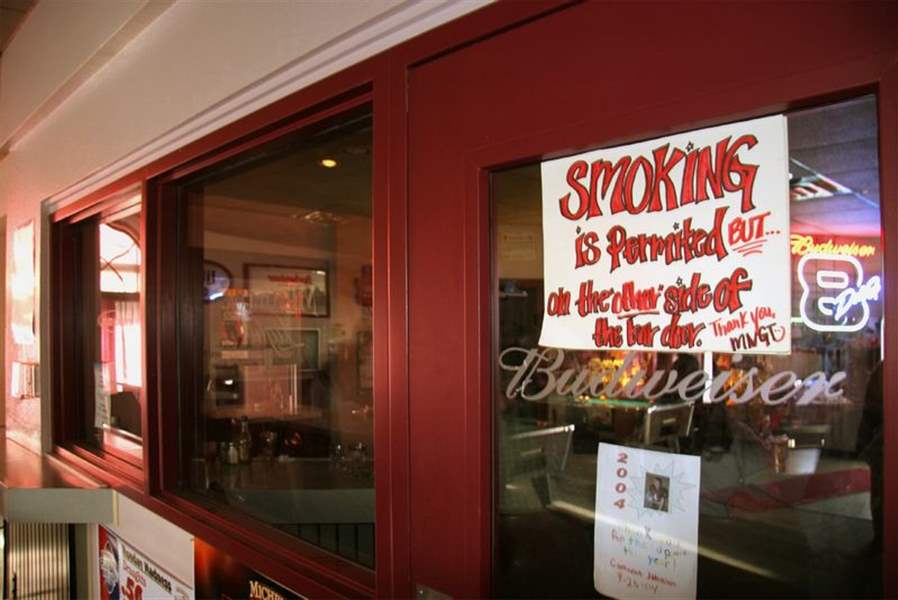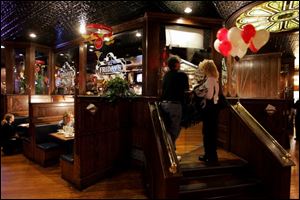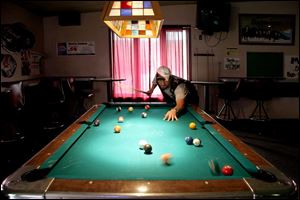
Larger smoking lounges spawn anxiety over cost, effectiveness
10/4/2004
A sign on the window at Myler's Rock Garden advises patrons that they can smoke in the bar, but in a designated area.
Allan Detrich / blade

Patrons enter the smoking room at TGI Friday's on Airport Highway, where the popularity of the smoking lounge has caused employees to seek job assignments in that area.
With an amendment to Toledo's smoking ban on the Nov. 2 ballot that would allow restaurants to increase the size of their smoking lounges, questions about the costs, effectiveness, and feasibility of such lounges are moving to the fore of Toledo's smoking debate.
Some health officials claim that such lounges still pose dangers to nonsmokers, and while establishment owners say they have yet to hear a complaint, some worry about the cost and mechanics of such lounges - especially during the wintertime months, when the costs of constantly heating and circulating new air can skyrocket.
"Putting the fans in is only one component. You have to build walls, modify the air conditioning system, maybe add new units..." said Brad Rossi, architect in charge and vice president of Rossi & Associates, which has designed about 25 smoking rooms for bars and restaurants in the Toledo area.
Nonetheless, such lounges have spread across the Toledo landscape in the last year: In all, 74 have been approved by the city to date. And so far, city officials are happy with how they're working.
"We're pretty happy with the way things are now. The ones that are out there and functioning have been doing the job," said Clinton Wallace, chief building official for the city of Toledo's building inspections department. "I was kind of surprised. The architects in the area had quite a bit of knowledge of how to build these things to code."

Khris Trull lines up his next shot on the pool table in the nonsmoking section at Myler's Rock Garden on Telegraph Road.
Mr. Rossi said that even with the proposed amendment in place - which would increase a lounge's allowable size to 50 percent of a restaurant's total service area; up from 30 percent under the current ban - he believes there will be little difference in lounges' basic makeup.
They still must maintain "negative pressure" - keeping the air flowing out of lounge vents greater than the rate of the air flowing in, and thus sucking itinerant trails of smoke away from nonsmoking areas. Also, the ventilation system must expel air at least 10 feet from windows, doors, and any other ventilation intake. The layout of the room cannot block restrooms, entrances, or exits that are used by nonsmokers.
But an increased size could press some ventilating systems to their limits, especially in the winter months. Add that to the fact that negative pressure can be a delicate balance - and with larger rooms, an expensive one.
"If there is environmental tobacco smoke, rooms have to be ventilated at a higher rate," said Denis Stanke, vice chairman of the American Society of Heating, Refrigerating and Air-Conditioning Engineers' ventilation and acceptable indoor air quality committee.
"But if it's too much negative pressure, furnaces, fireplaces water heaters will back draft and bring in fumes that are supposed to go out the chimney," Mr. Rossi said.
"When you get to bigger rooms, you need more equipment, added intakes, or it would be really windy in there. Really uncomfortable," Mr. Stanke said.
Then, you've got to worry about wintertime.
"Almost all of those ventilation systems were designed for temperature control, not to address contaminants," said Scott Roberts, national sales and marketing manager at Honeywell International Inc. Commercial Air Products, an air cleaning system design/manufacturing firm in Niceville, Fla. During winter, Mr. Roberts said, you have to bring in a lot of air, and heat it quickly, then dump it outside again.

A sign on the window at Myler's Rock Garden advises patrons that they can smoke in the bar, but in a designated area.
"That amount of air is a tremendous amount, and it can be cost-prohibitive," he added.
"A lot of people just modified their intake unit to bring in more fresh air, which will eventually ruin it," Mr. Rossi agreed.
With small bars, the problem can be creating a lounge in the first place.
"The problem with a small bar is when you try to divide it, you can't get to both exits and to the toilet room without going through the smoking area. With some, it's almost impossible without building a corridor right though the middle of the smoking area to get to the back exit," Mr. Rossi said.
The two places Mr. Rossi identified as "unlucky" include two establishments owned by those heavily involved in the fight for the amendment: the Distillery, owned by Jim Avolt; and Delaney's Lounge, owned by Bill Delaney.
"We charge people to come in and listen to a band. So where do you put the wall?" Mr. Avolt said. "Plus, in the middle of winter, you have to bring in new, warm air every 8 minutes. That burns a lot of energy."
And as a renter, Mr. Delaney would have to get permission from his landlord to do any major work - also a problem, and the bottom line with many places, according to a mechanical engineer who consults with Mr. Rossi, who placed the costs of such lounges at anywhere between $5,000 to $85,000, depending on how bars were laid out.
On the very tip of the high end of those designed was TGIF's on Airport Highway. With its new air system, multiple exhaust fans changing the air every 3 to 5 minutes, elevator for handicapped smoking guests, etched glass walls and loads of negative pressure, the room is seen as a model smoking room by some area designers.
Matt Morris, general manager of TGIF's, declined to say how much his room cost, but did say that energy costs for the lounge area were already up 30 to 40 percent.
But the lounge is popular. In fact, it may even be working too well.
"Our bar business has increased, but the dining business has declined somewhat," Mr. Morris said. "Most of our waitresses want to be bartenders in that area."
For those smaller, neighborhood bars, even when a room is feasible, it can be tempting not to spend the money.
Patty Brown, manager of Myler's Rock Garden on Telegraph Ave., claims her lounge cost around $50,000, including ventilation, ductwork, walls. Now, she looks through that glass wall, out at her nonsmoking section and the two pool tables it holds.
"There's nobody ever out there," she said. "They go out to shoot a game once in a while - and look at it in here, feels like we're in a dungeon."
"But at least it helped with business," she added.
Other neighborhood bars fared better.
Bart Young, owner of the Lair Lounge, which was originally two storefronts, already had a separate ventilation unit, and a partial wall in place.
The lounge cost $10,000, Mr. Young said. "It hurt, but it wasn't a showstopper."
"Every time you open a door, you get an air pumping motion that moves air nearly regardless of the differential pressure," Mr. Stanke said.
And that's the crux of the health debate - a debate further clarified by Leon Alevantis, deputy chief of the indoor air quality section of California's Department of Health Services.
Mr. Alevantis was charged with designing the best standards for smoking rooms, once California's state ban permitted smoking lounges in cities that didn't have stricter bans themselves that prohibited them.
His research found that a certain amount of pressure - 5 to 7 pascals, to be precise - "should be sufficient enough to keep the smoke out of smoke-free areas."
"It's probably one of the best ways to contain smoking to one area of a building with minimum leakage. That's the approach California took," he said.
Still, Mr. Alevantis said, even with that amount, "You are still going to have about a five percent leakage," he said.
For that reason, his recommendations include - in addition to using negative pressure - using sliding doors, rather than swinging doors, and making sure that walls go all the way up. In other words, watch for lowered ceilings.
A study released in August by the Medical College of Ohio and funded by the Ohio Tobacco Use Prevention and Control Foundation found that several contaminants usually associated with second-hand smoke were still present - albeit in very small amounts - in nonsmoking areas of two establishments with smoking lounges in Toledo and Bowling Green.
"After the ban, still we have nonsmoking areas polluted," said research head Farhang Akbar-Khanzadeh, who holds a doctorate in occupational hygiene and is a professor of public health at MCO.
But Mr. Akbar-Khanzadeh did admit that out of the two smoking establishments studied, one of them had a permanent opening between the nonsmoking and smoking section: A space behind the serving bar for servers to walk through, which smoke flowed through uninhibited.
He also said that because of time restraints, researchers were unable to test whether negative pressure was present in either lounge, saying only that they were "well ventilated."
In a second study of eight smoking lounges in the Toledo area, conducted before the ban, Mr. Akbar-Khanzadeh said while the quantity of ventilation in smoking lounges was good, the quality was not: that vents didn't cover corners of rooms, or evenly distribute the air.
The conclusion of the latest study was that "to fully protect employees or patrons, 100 percent smoke-free policies should be established."
In other words, ditch the smoking lounges too.
Those in the air quality industry say that health officials are not being realistic.
"You can have a tuberculosis room with a tuberculosis patient in it and its protected by negative pressure and filtration, and that's supposed to work," said Mr. Roberts. "Why wouldn't it work for second-hand smoke?"
Still, most architects and designers, including Mr. Roberts, want to steer far clear of that debate.
"Is a smoking lounge totally effective? No. Is it effective enough? That's up to some expert to decide," Mr. Stanke said.
Contact Tad Vezner at: tvezner@theblade.com or 419-724-6050.